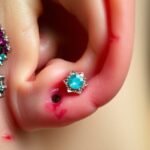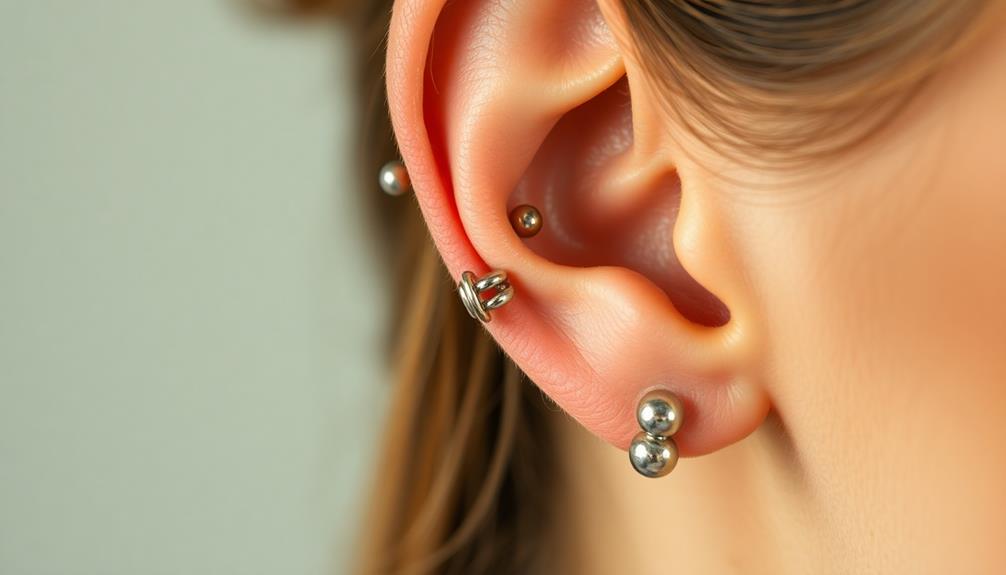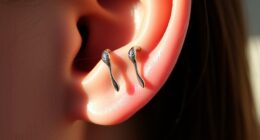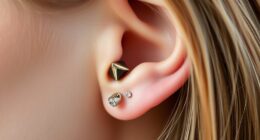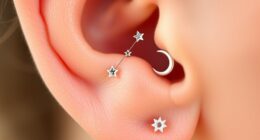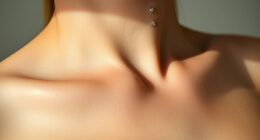Getting a piercing as a senior can be a fun way to express yourself, but you need to take into account a few important factors. Chronic health issues may complicate healing, increasing infection risks. Your skin's sensitivity might lead to more pronounced scarring, so choose high-quality, hypoallergenic jewelry. Additionally, lifestyle habits, like smoking, can impact recovery times. Be mindful of your environment; activities like swimming may increase infection risks. Workplace policies on piercings vary, so check your industry's guidelines. To guarantee a safe experience, selecting the right studio is essential. Explore these aspects further to ensure a successful piercing journey.
Key Takeaways
- Disclose any chronic health issues, as they can complicate the piercing process and increase the risk of infections.
- Choose a reputable piercing studio that prioritizes hygiene and uses sterile equipment to minimize complications.
- Select high-quality, hypoallergenic jewelry to promote better healing and reduce irritation during the recovery process.
- Follow strict aftercare routines, including cleaning with saline solution and avoiding natural waters, to prevent infections.
- Consider timing piercings during fall or winter to reduce environmental risks associated with healing.
Health Risks to Consider
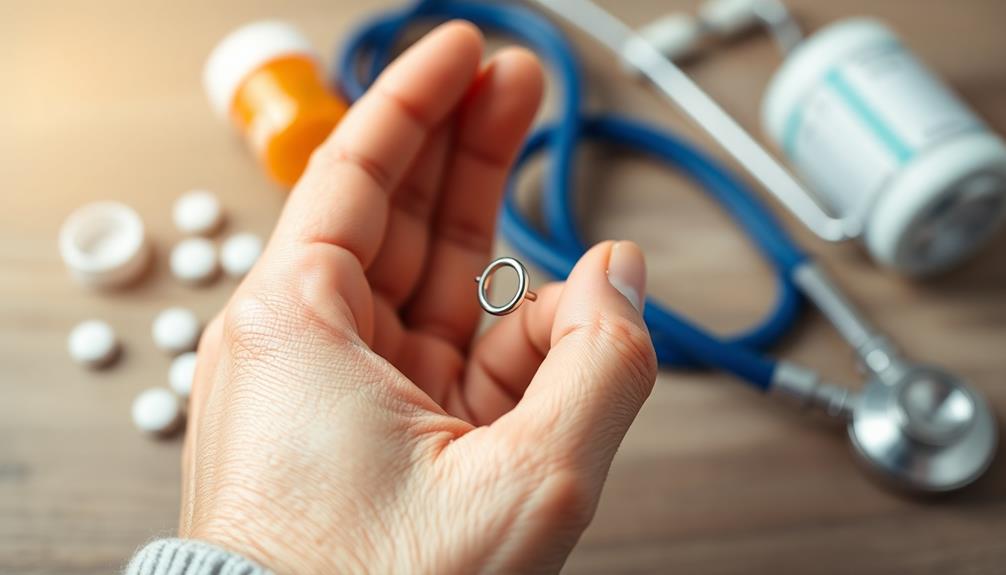
When considering getting a piercing as a senior, it's important to be aware of the health risks involved. As you age, chronic health issues like diabetes or circulatory diseases can complicate the piercing process. These conditions may lead to increased healing times and a higher risk of infection, so it's necessary to keep that in mind.
You should also consider how age-related changes in skin elasticity and circulation can affect your healing period. These changes can make you more susceptible to complications like keloids or hypertrophic scars.
If you're on anticoagulant medications, you might experience excessive bleeding during and after the piercing, so consulting a healthcare provider beforehand is crucial.
Moreover, a weakened immune system increases your risk for infections, making aftercare and hygiene practices more important than ever. To minimize complications, it's important to disclose any underlying health conditions to your piercer.
They can help guarantee that safe practices are followed, allowing you to enjoy your new piercing while also being mindful of the health risks associated with it.
Scarring and Skin Sensitivity
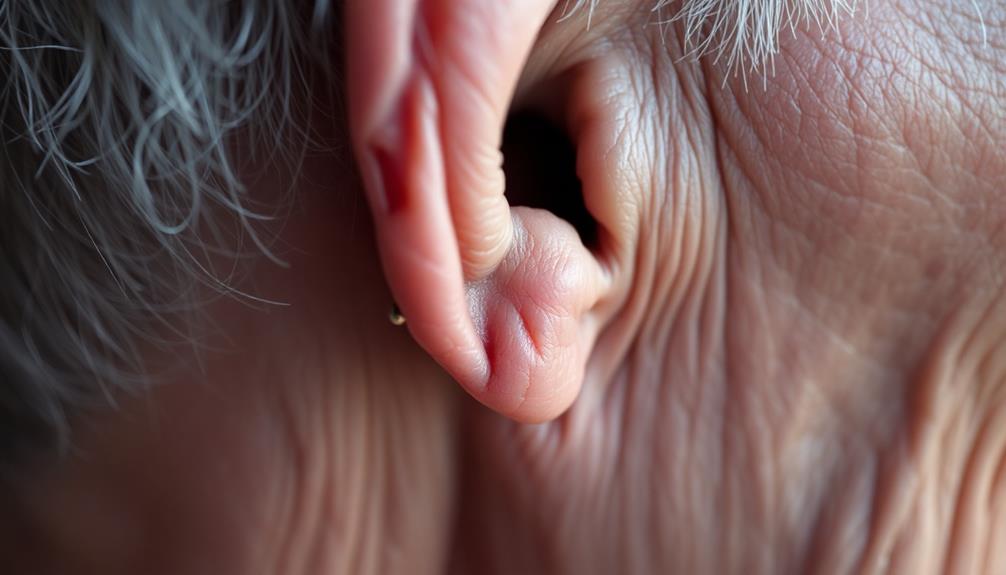
Age-related changes in skin elasticity and circulation can make scarring and skin sensitivity important concerns for seniors contemplating piercings.
With increased skin sensitivity, you might find that your skin reacts differently to piercings than it did in your younger years. This sensitivity can lead to prolonged healing times and complications, making it necessary to be mindful of your skin's condition.
If you have a history of excessive scarring, such as keloids or hypertrophic scars, it's essential to take this into account before getting pierced.
Darker skin tones often display more pronounced scarring, and a healing piercing can exacerbate these tendencies. Chronic health issues, like diabetes or circulatory diseases, can further complicate the healing process, increasing the likelihood of complications.
To minimize scarring and guarantee successful healing, proper aftercare is critical.
Always follow professional guidance post-piercing, as this can greatly influence the outcome. Being proactive about your skin's sensitivity and scarring tendencies can help you make informed decisions, ensuring that your experience with piercings is both safe and satisfying.
Lifestyle Factors Impacting Healing

Several lifestyle factors can greatly impact your healing process after getting a piercing. If you smoke or are obese, your body's healing capabilities may be greatly hindered, leading to prolonged recovery times and increased infection risks.
It's vital to assess any chronic health issues, such as diabetes or circulatory diseases, before proceeding with a body piercing, as these can also impede healing and raise the likelihood of complications. Additionally, understanding the financial considerations for elderly care can help guarantee that you have the resources needed for a safe and healthy recovery.
High stress levels can negatively affect your immune response, making it important to maintain a healthy lifestyle to support your recovery. Additionally, if you're intoxicated during the piercing process, your judgment may be impaired, which could lead to poor decision-making and complications.
Another significant consideration is your activities post-piercing. Engaging in swimming, especially in natural waters, can complicate the healing process, so it's wise to wait until you're fully healed before diving in.
Environmental Considerations

When considering a new piercing, think about the environmental factors that could affect your healing.
Seasonal activities like swimming or camping can introduce challenges, especially if you can't maintain proper aftercare.
Plus, if you're traveling or facing harsh weather, you'll need to take extra steps to keep your piercings clean and safe.
Seasonal Healing Challenges
During the summer months, getting a new piercing can pose unique challenges to the healing process. Seasonal activities often lead to increased exposure to water, sunlight, and outdoor environments, which can harbor bacteria and increase the risk of infections.
If you're camping or traveling during this time, you might find access to clean water and sanitation limited, complicating your aftercare instructions. Additionally, maintaining good air quality can be beneficial during the healing process; using an air purifier can help reduce allergens and irritants that may affect your skin.
Humidity can also impact your skin's elasticity and healing, potentially causing irritation or discomfort. Plus, with more outdoor activities, the risk of trauma to your new piercings rises considerably. Physical sports and even casual games can jostle your piercings, leading to complications that might require additional care.
To minimize these risks, it's advisable to think about delaying new piercings until the fall or winter months when environmental factors are less likely to interfere with healing.
By doing so, you can enjoy your seasonal activities without compromising your health and safety. Remember, taking the time to guarantee proper healing is essential for long-term satisfaction with your piercings.
Prioritize your aftercare and choose the right timing for your new adornments.
Travel and Hygiene
Traveling can considerably impact your ability to maintain proper hygiene for new piercings, especially in areas where access to clean water is limited.
To minimize the risk of infection, you'll need to be proactive about your hygiene practices.
Here are three important tips to keep in mind while traveling:
- Pack Saline Solution or Antiseptic Wipes: Regularly clean your piercings with these items. They're essential for preventing complications during the healing process.
- Avoid Swimming in Natural Bodies of Water: This can expose your new piercings to bacteria and contaminants, increasing the risk of infection.
- Wash Your Hands Thoroughly: Always clean your hands before touching your piercings. This is critical in travel situations where hygiene may be inconsistent.
If you're camping or in a location with questionable sanitation, it might be wise to delay getting piercings until after your trip.
Additionally, be mindful of environmental factors like dust and dirt, which can irritate and infect fresh piercings.
Cover them appropriately to reduce exposure. Prioritizing hygiene will help guarantee a smooth healing process.
Activity-Related Risks
Engaging in various activities after getting a new piercing can pose significant risks to the healing process. For instance, summer activities like swimming expose your healing piercings to bacteria found in natural water sources, increasing the risk of infection.
If you're camping or traveling to areas with limited access to clean water, you might struggle with proper aftercare, making it wise to postpone piercings until you're back in a controlled environment.
Physical activities, including sports, can also lead to trauma or damage to your healing piercings, especially if your jewelry isn't securely fastened or if you don't take protective measures.
Additionally, seasonal weather changes can impact healing; cold weather might dry out your skin and irritate new piercings, while hot weather can cause excessive sweating and further irritation.
It's essential to schedule your piercings around major events or activities. Tender healing sites can be uncomfortable during rigorous physical exertion or social outings.
Workplace Policies on Piercings

Maneuvering workplace policies on piercings can be tricky, as these rules vary widely across different industries. Some environments are more conservative, imposing stricter guidelines regarding visible piercings, while others embrace a casual atmosphere that allows for greater flexibility.
Understanding your workplace's stance on piercings is essential for maintaining a professional appearance.
Here are three key considerations to keep in mind:
- Industry Standards: Know the norms of your industry. Healthcare and corporate sectors often have stricter policies, while creative fields may be more lenient with visible piercings.
- Dress Codes: Review your employer's dress code. Some companies may explicitly prohibit excessive piercings, while business casual settings might allow tasteful jewelry that still appears professional.
- Hiring Practices: Be aware that federal offices may not factor in piercings during hiring decisions, reflecting a more progressive outlook compared to traditional corporate environments.
Being informed about these workplace policies can help you make smart choices about your piercings, ensuring you maintain a professional appearance while expressing your individuality.
Types of Piercings Available

When considering piercings, you'll find a variety of options that cater to different tastes and comfort levels.
Popular choices include earlobe and cartilage piercings, as well as nose piercings for those feeling adventurous.
It's important to prioritize safety and understand the healing times associated with each type to guarantee a smooth experience.
Popular Piercing Options
As you consider getting piercings as a senior, a variety of popular options are available to suit your style and comfort level. Here are three options worth exploring:
- Ear Piercings: Traditional ear lobe piercings remain a timeless choice. You can also opt for cartilage piercings if you're looking for something a bit edgier.
- Nipple Piercings: These can be an exciting option, especially since they don't block milk ducts, making them suitable for those who aren't breastfeeding.
- Oral Piercings: Consider tongue or lip piercings, but be aware that they require careful aftercare to avoid damage to your dental structures.
Facial piercings, like nostril and septum options, are also gaining popularity among seniors, allowing for personal expression.
While genital piercings are less common, they're safely performed by trained professionals and typically heal within one to two months.
Surface piercings are another unique choice, offering long-term temporary body modification.
No matter what you choose, it's important to pick a piercing that resonates with you and feels comfortable!
Safety and Healing Tips
Getting a piercing can be an exciting journey, but prioritizing safety and healing is fundamental. First, choose a reputable studio that follows strict hygiene regulations. This is essential for minimizing infection risks, especially if you have underlying health conditions, as individuals with certain mental health disorders, such as Borderline Personality Disorder (BPD), may experience heightened emotional responses that could complicate the healing process.
Popular options like traditional ear lobe piercings, helix piercings, and nose piercings typically involve minimal healing complications when done by experienced professionals.
Opt for high-quality, hypoallergenic jewelry made from materials like surgical stainless steel or titanium. This selection reduces the risk of allergic reactions and promotes better healing outcomes.
After your piercing, proper aftercare is important. Clean your piercings with a saline solution regularly and avoid touching or twisting the jewelry, as this can lead to irritation and infection.
Before you proceed, consult your healthcare provider. Discuss any chronic health issues or medications that might affect your healing process or increase the risk of infection.
Jewelry Selection and Aftercare
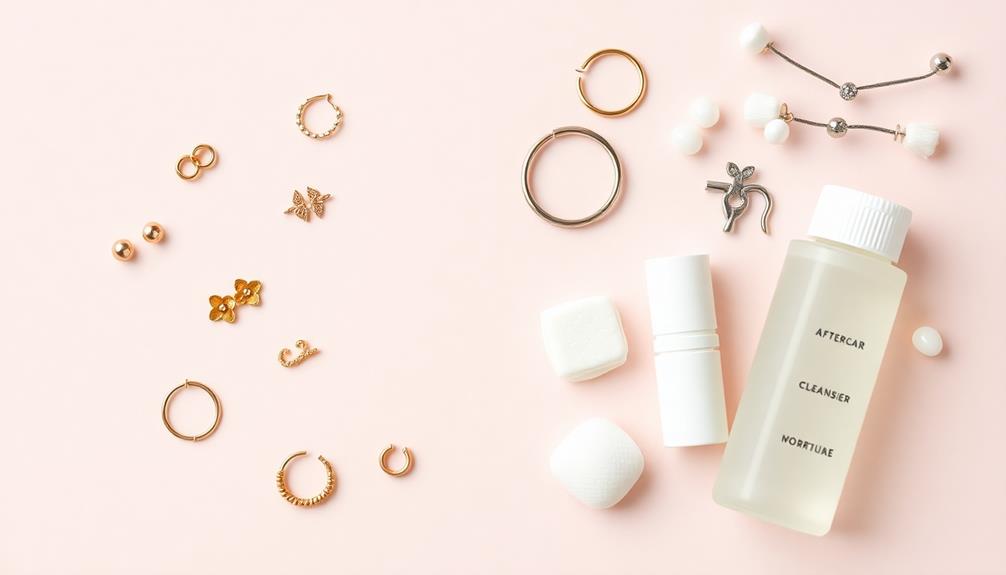
Choosing the right jewelry and proper aftercare are vital for a successful piercing experience. High-quality materials like surgical stainless steel, titanium, or 14K gold minimize the risk of allergic reactions and guarantee durability.
Here are some important tips for jewelry selection and aftercare:
- Select Smooth-Finished Jewelry: Choose pieces with a smooth finish to reduce irritation and facilitate healing. The appropriate gauge size is significant, so consult with your piercer for recommendations.
- Follow Aftercare Instructions: Clean your piercings regularly with a saline solution or a mild antiseptic specified by your piercer. Avoid harsh chemicals like hydrogen peroxide, as they can damage healing tissue.
- Be Patient with Jewelry Changes: Wait until your piercing is fully healed before changing jewelry. This typically takes 6-8 weeks for earlobe piercings and longer for cartilage or more complex ones.
Monitoring for signs of infection—like increased redness, swelling, or discharge—is also important. If symptoms persist beyond 24 hours, seek medical advice.
Complications and Prevention Tips
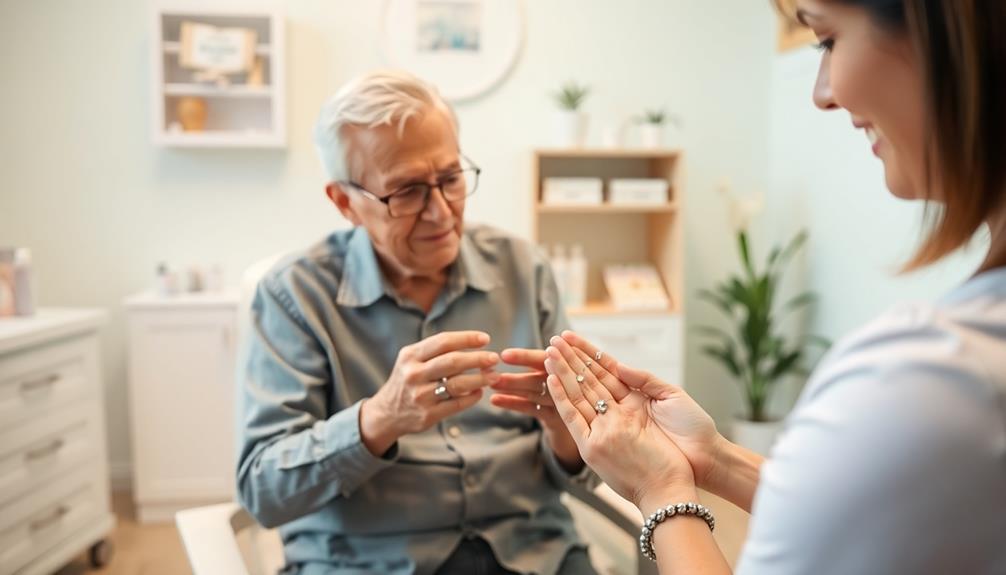
When you get a piercing, you're at risk for complications like infection and discomfort, so it's essential to stay informed.
Managing infection risk starts with proper hygiene and choosing the right jewelry, while understanding the healing process can help you avoid common pitfalls.
Common Complications Overview
Although many seniors choose to get piercings, it's important to be aware that complications can arise, affecting up to 35% of individuals. When getting a piercing, you could experience common complications such as discomfort, infection, or even embedded earrings.
These issues often stem from unclean instruments or allergic reactions, making vigilance essential. Additionally, maintaining good hygiene is critical for a successful healing process, similar to the importance of regularly checking and cleaning filters in air purifiers.
Here are three key tips to help prevent complications and guarantee a smoother healing process:
- Wash your hands before touching the piercing to minimize bacteria transfer.
- Clean the area with a saline solution as directed by your piercer, avoiding harsh cleansers like hydrogen peroxide, which can harm your skin and lead to prolonged healing.
- Keep hair away from new piercings to further reduce the risk of infection.
Be alert for symptoms like pain, redness, pus, or swelling that lasts over 24 hours. Monitoring these signs is crucial for addressing any complications early on.
Infection Risk Management
After considering the common complications associated with piercings, managing infection risk becomes a top priority. If you have chronic health issues like diabetes, consult your healthcare provider before getting your ears pierced, as you face a heightened risk of infection and prolonged healing times.
Additionally, certain types of piercings, like clitoral hood piercings, may have specific aftercare requirements, so understanding piercing care and hygiene is vital for success.
To reduce your chances of infection, wash your hands thoroughly before touching your newly pierced areas. Clean your piercings with saline solution as directed, and steer clear of harsh cleansers like hydrogen peroxide, which can harm healing tissue.
It's also wise to keep hair away from your new piercings to minimize bacteria transfer.
Don't remove your earrings prematurely—it's important to keep them in for at least eight weeks to allow proper healing and to prevent complications.
Regularly monitor for symptoms like pain, redness, pus, or swelling lasting more than 24 hours. If you notice any of these signs, seek medical intervention promptly to address potential infections.
Healing Process Tips
To guarantee a smooth healing process for your new piercings, it's essential to prioritize cleanliness and monitor your body's reactions closely. Proper aftercare can considerably reduce the risk of complications such as infection, discomfort, and embedded earrings, which can affect up to 35% of individuals post-piercing.
Similar to how mammography aims to detect issues early, being proactive about your piercing care can lead to better outcomes.
Here are some essential healing process tips to follow:
- Clean Regularly: Use a saline solution to clean your piercings daily. Avoid harsh cleansers like hydrogen peroxide, as they can harm healing skin.
- Watch for Symptoms: Keep an eye out for signs of infection, such as pain, redness, pus, or swelling lasting over 24 hours. If you notice any of these symptoms, seek medical attention promptly.
- Limit Exposure: Avoid swimming in natural waters during the healing period. Bacteria in these environments can increase the likelihood of infection.
Additionally, keep hair away from your new piercings and always wash your hands before touching them.
Following these tips will help guarantee your piercings heal properly and minimize complications.
Emotional and Psychological Aspects

Getting a piercing as a senior can be a powerful way to embrace self-expression and reclaim your identity. This journey allows you to assert who you are during a phase of life that can feel limiting. Research shows that body modifications, like piercings, can considerably enhance personal confidence and foster a positive self-image.
However, emotional responses to getting pierced vary. While some seniors experience liberation and joy, others may feel anxiety about societal perceptions. Understanding your feelings can help you navigate this decision more comfortably.
Here's a breakdown of the emotional impacts of piercings:
| Aspect | Positive Emotional Responses | Negative Emotional Responses |
|---|---|---|
| Self-Expression | Liberation, Joy | Anxiety, Insecurity |
| Personal Confidence | Empowerment, Pride | Doubt, Fear of Judgment |
| Connection to Youth | Engagement, Trendiness | Isolation, Age Stereotypes |
| Cultural Background | Acceptance, Belonging | Conflict, Resistance |
Ultimately, understanding these emotional and psychological aspects can help you make a more informed decision about getting a piercing, promoting a positive experience that aligns with your identity.
Choosing the Right Piercing Studio
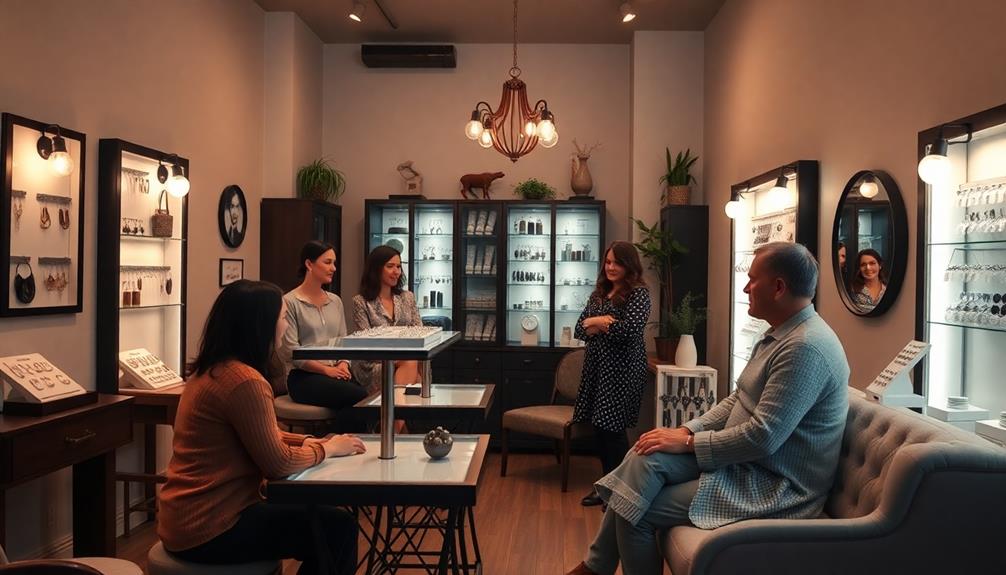
When evaluating a piercing, finding the right studio is essential for guaranteeing a safe and positive experience. You want to prioritize studios that are licensed and comply with local health regulations.
It's important to verify that your body is healthy enough for a new piercing, as certain conditions may complicate the healing process. Additionally, be mindful of any allergies or sensitivities that could affect your experience, similar to how some dogs may react adversely to new foods, such as grapes being toxic for them.
Here are three key factors to take into account when choosing the right piercing studio:
- Credentials: Look for piercers with certifications from recognized organizations like the Association of Professional Piercers (APP). This guarantees they follow safe practices in body modification.
- Cleanliness and Practices: Visit the studio in person. Assess the cleanliness and sterilization practices. Make sure they use single-use, sterile needles instead of piercing guns, which can pose health risks.
- Reputation and Aftercare: Read reviews and ask for recommendations from trusted sources. A reputable studio will provide detailed aftercare instructions and be willing to answer any questions you may have about the piercing process, which is crucial for successful healing and minimizing complications.
Frequently Asked Questions
Can Elderly People Get Piercings?
Yes, elderly people can get piercings. Just make certain you consult with your healthcare provider first. Consider your health status and choose high-quality jewelry to minimize risks and guarantee a safe experience.
Am I Too Old for Piercings?
Age is just a number, like a canvas waiting for vibrant colors. You're never too old for piercings! Embrace your individuality and express yourself; confidence and self-expression know no age limits. Go for it!
Who Should Not Get Piercings?
You shouldn't get piercings if you have chronic health issues, blood clotting disorders, or are immunocompromised. Additionally, if you've experienced keloids or are pregnant, it's best to avoid them for safety reasons.
What Are the Contraindications for Piercings?
Getting piercings can feel like diving into unknown waters. If you've got chronic health issues, blood disorders, or a history of keloids, it's essential to consult a healthcare provider before proceeding to avoid complications.
Conclusion
Getting a piercing as a senior can be a rewarding experience, but it's important to weigh the risks and considerations. Did you know that about 20% of adults over 60 have at least one body piercing? That's one in five people embracing this form of self-expression! By choosing the right studio and following aftercare tips, you can enjoy your new piercing while minimizing complications. So go ahead—if it feels right for you, take the plunge!
Hi, my name is Danielle, and I’m an author for piercings-body.com. I have a passion for writing and love to share my knowledge on all things body piercing-related. I’m also a huge advocate for safe body modification practices and believe everyone should be able to make informed decisions about their bodies. When I’m not writing or blogging, I enjoy spending time with my family and friends, practicing yoga, and exploring new places.



